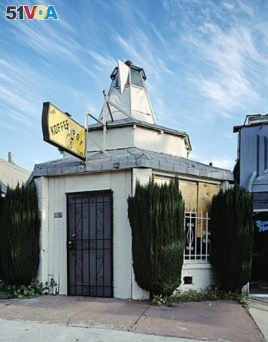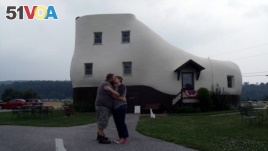July 09, 2012
In the first half of the 20th Century, state governments furiously built highways to accommodate Americans’ growing passion for the automobile.
These roads were nothing like today’s wide, high-speed interstates. They were only two lanes, and they wound through every little town and big city.
Because it took many days to get even part-way across the country, drivers and their families were always on the lookout for something to break the monotony.
So, all along the road, entrepreneurs built little amusement parks and restaurants and mom-and-pop motels called “motor courts.”
Snake farms, caves and caverns, little zoos, and other attractions, too. Nearly every place was individually owned and run.
And some owners got really creative, turning their businesses into eye-catching tourist attractions, like giant coffee pots, or huge hamburgers, Dutch windmills, railroad passenger cars, or ships.

You'll notice that the top portion of the Koffee Pot restaurant in Long Beach, California, fits the name of the business perfectly. (Carol M. Highsmith)
Not signs that looked like this. Entire buildings shaped like a life-sized blimp, or the old lady’s high-top shoe from a famous nursery rhyme.
Near Everett, Pennsylvania, someone built an ice-cream shop in the shape of a scoop of ice cream, topped with chocolate sauce and a cherry.
Elsewhere, you’d see businesses in the form of donuts, lighthouses - even a full-sized Lockheed Super G Constellation airplane, complete with propeller. It was a cocktail lounge.
But as high-speed interstate highways lured drivers off the two-lane roads and traffic on the old by-ways slowed to a trickle, a lot of the odd attractions went out of business.
And the traveling public became obsessed with uniformity.
If we saw a Kentucky Fried Chicken sign in Wyoming, we knew the chicken would taste pretty much like it did in Indiana.

The Haines Shoe House in Pennsylvania was a guest house that suggested the nursery rhyme beginning, “There was an old lady who lived in a shoe." (lemonhalf, Flickr Creative Commons)
But if we saw a restaurant shaped like a chicken, we’d think, “That looks weird!” and probably not stop. Even if the food was good there, we knew the service would not be as speedy as it would be in a fast-food outlet.
A very few of the old, idiosyncratic places still stand, and even fewer are still in operation.
Most have been torn down and long forgotten. But for those who saw them, and stopped in, there are many smiles that go with the memories.